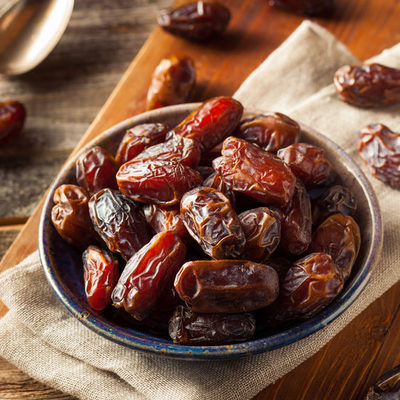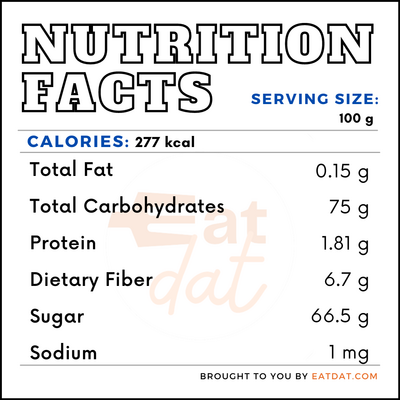
Dates
What are Dates?
Dates are the edible fruit of the date palm tree, where they grow in clusters. These sweet fruit are native to the Middle East and are cultivated throughout. As well as in South Asia and North Africa.These fruits are known to be one of the sweetest in the world and are often consumed dried, though this is also available and used in different cuisines. There are more than 3,000 varieties.
- Each variety has its own distinctive properties and cultivation practices.
- The total annual production is currently 8.5 million metric tons and about 3% of the world’s cultivated surface area is taken up by date palms.
There are many different varieties, including:
- Medjool
- Deglet Noor
- Barhi
- Piarom
- Mazafati
- Rabbi
- Thoori
- Sayer
- Dayri
- Halawy
- Sukkari
- Khudri
- Zahidi
- Safawi
Origin of dates
The date palm tree has been around for a long time and its exact origin is not known. There are records showing that date palm was in use in Iraq in 4,000 BC. Date palm was also cultivated in Egypt, and it represents a year in Egyptian hieroglyphics. Archaeological research also shows the use of dates among the Sumerians, Akadians, and Babylonians, who ate this fruit as medicine. It is possible that the date palm originated from either tropical Africa or India.
Both Jews and Muslims consider dates as holy. It is mentioned in both the Talmud and Quran. Abraham, Mohammed, and other religious leaders in the ancient past have openly extolled the virtues of date. The fruit was introduced into other countries over time and by the 6th century AD, it was produced throughout the Middle East and African regions. Date was introduced into the desert areas of North America in the 19th century, where it flourished.
Nutrition
This fruit is full of sugar and a high source of energy. A single date is jampacked with nutrients. The fruit contains iron, copper, selenium, potassium, calcium, magnesium, phosphorous, and sodium. A 100-g serving contains the nutritional value of:

Consumption promotes good bone health, better metabolic function, red blood cell production. The fruits are considered to be good for people with hypertension because of the low sodium and high potassium content. In addition, dates also contain amino acids, antioxidants, B-complex and C vitamins and dietary fiber.
Despite the high sugar content, dates are also suitable for diabetics due to their low glycemic index.
Date Recipes
These are very versatile fruits and can be used in different types of recipes. Here are a few ways in which dates can be used.
FDA regulations
The FDA defines dried fruits as any fruit that are dried without any additional manufacturing / processing beyond drying/dehydrating, packaging, and/or labeling. The labeling and processes of dried dates, the most commonly found variety, are strictly regulated, as are the products such as date syrup made from dates.
References
Abdelouahhab Zaid, Chief Technical Adviser/Director UNOPS – Date Palm Research & Development Programme, United Arab Emirates, Food and Agricultural Organization of the United Nations, Rome, 2002
http://www.fao.org/3/Y4360E/y4360e06.htm
Eman Abdul Rahman Assirey, Nutritional composition of fruit of 10 date palm (Phoenix dactylifera L.) cultivars grown in Saudi Arabia, Journal of Taibah University for Science, Volume 9, Issue 1, 2015, Pages 75-79, ISSN 1658-3655, https://doi.org/10.1016/j.jtusci.2014.07.002.
https://www.sciencedirect.com/science/article/pii/S1658365514000703
